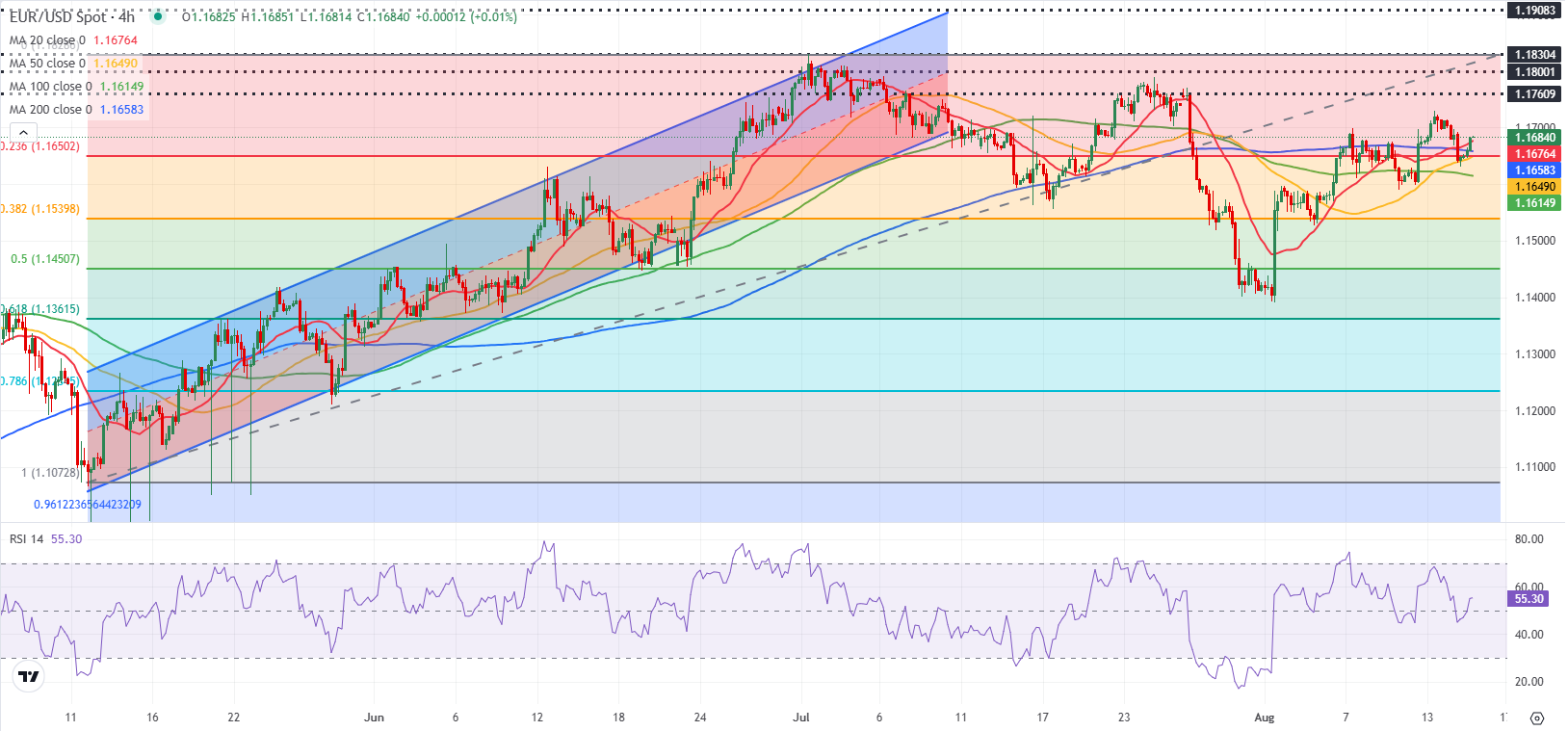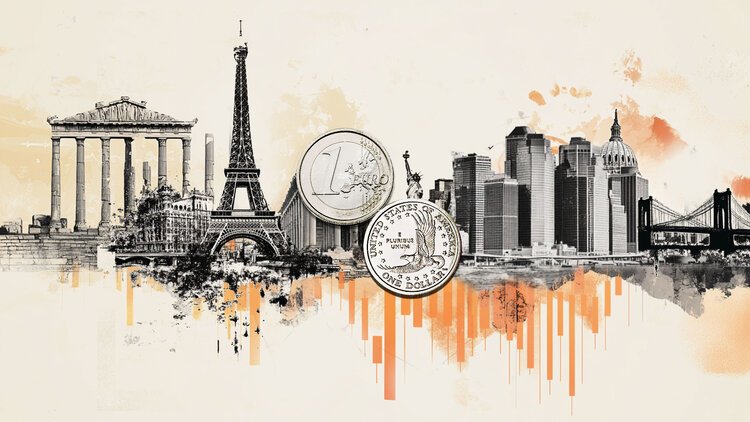- EUR/USD trades in positive territory above 1.1650 on Friday.
- US economic calendar will feature Retail Sales and consumer sentiment data.
- The technical outlook highlights a neutral stance in the short term.
EUR/USD gains traction and rises toward 1.1700 in the European session on Friday after closing in negative territory on Thursday. The pair’s near-term technical outlook is yet to show a buildup of directional momentum. High-tier macroeconomic data releases from the US could drive EUR/USD’s action heading into the weekend.
Euro PRICE This week
The table below shows the percentage change of Euro (EUR) against listed major currencies this week. Euro was the strongest against the New Zealand Dollar.
| USD | EUR | GBP | JPY | CAD | AUD | NZD | CHF | |
|---|---|---|---|---|---|---|---|---|
| USD | -0.30% | -0.80% | -0.43% | 0.30% | 0.16% | 0.51% | -0.39% | |
| EUR | 0.30% | -0.49% | -0.10% | 0.62% | 0.47% | 0.77% | -0.08% | |
| GBP | 0.80% | 0.49% | 0.36% | 1.12% | 0.97% | 1.28% | 0.42% | |
| JPY | 0.43% | 0.10% | -0.36% | 0.78% | 0.63% | 1.02% | 0.19% | |
| CAD | -0.30% | -0.62% | -1.12% | -0.78% | -0.14% | 0.16% | -0.71% | |
| AUD | -0.16% | -0.47% | -0.97% | -0.63% | 0.14% | 0.31% | -0.54% | |
| NZD | -0.51% | -0.77% | -1.28% | -1.02% | -0.16% | -0.31% | -0.84% | |
| CHF | 0.39% | 0.08% | -0.42% | -0.19% | 0.71% | 0.54% | 0.84% |
The heat map shows percentage changes of major currencies against each other. The base currency is picked from the left column, while the quote currency is picked from the top row. For example, if you pick the Euro from the left column and move along the horizontal line to the US Dollar, the percentage change displayed in the box will represent EUR (base)/USD (quote).
The US Dollar gathered strength against its rivals on Thursday as the hot producer inflation data caused markets to assess the probability of the Federal Reserve (Fed) lowering the policy rate three times this year.
The Producer Price Index (PPI) rose by 3.3% on a yearly basis in July. This reading followied the 2.4% increase recorded in June and surpassed the market expectation of 2.5% by a wide margin. On a monthly basis, the PPI and the core PPI both rose by 0.9%.
The probability of a total 75 basis points reduction in the Fed policy rate by the end of the year declined below 45% from nearly 55% before the release of the producer inflation data, according to the CME FedWatch Tool.
In the second half of the day, July Retail Sales and the University of Michigan’s (UoM) preliminary Consumer Sentiment Index data for August will be featured in the US economic calendar.
Investors expect Retail Sales to rise by 0.5%. A significant positive surprise, with a print above 1%, could boost the USD with the immediate reaction and weigh on EUR/USD. Meanwhile, markets will pay close attention to the One-year Consumer Inflation Expectations component of the UoM survey. A noticeable decline in this data could hurt the USD.
EUR/USD Technical Analysis

The Relative Strength Index (RSI) indicator on the 4-hour chart holds slightly above 50, while EUR/USD struggles to pull away from the 200-period Simple Moving Average (SMA), reflecting the pair’s indecisiveness.
On the upside, 1.1720 (static level) could be seen as the first resistance level before 1.1760 (static level) and 1.1800 (static level, round level). Looking south, support levels could be spotted at 1.1660-1.1650 (200-period SMA, Fibonacci 23.6% retracement of the latest uptrend), 1.1620 (100-period SMA) and 1.1600 (static level, round level).
Euro FAQs
The Euro is the currency for the 19 European Union countries that belong to the Eurozone. It is the second most heavily traded currency in the world behind the US Dollar. In 2022, it accounted for 31% of all foreign exchange transactions, with an average daily turnover of over $2.2 trillion a day.
EUR/USD is the most heavily traded currency pair in the world, accounting for an estimated 30% off all transactions, followed by EUR/JPY (4%), EUR/GBP (3%) and EUR/AUD (2%).
The European Central Bank (ECB) in Frankfurt, Germany, is the reserve bank for the Eurozone. The ECB sets interest rates and manages monetary policy.
The ECB’s primary mandate is to maintain price stability, which means either controlling inflation or stimulating growth. Its primary tool is the raising or lowering of interest rates. Relatively high interest rates – or the expectation of higher rates – will usually benefit the Euro and vice versa.
The ECB Governing Council makes monetary policy decisions at meetings held eight times a year. Decisions are made by heads of the Eurozone national banks and six permanent members, including the President of the ECB, Christine Lagarde.
Eurozone inflation data, measured by the Harmonized Index of Consumer Prices (HICP), is an important econometric for the Euro. If inflation rises more than expected, especially if above the ECB’s 2% target, it obliges the ECB to raise interest rates to bring it back under control.
Relatively high interest rates compared to its counterparts will usually benefit the Euro, as it makes the region more attractive as a place for global investors to park their money.
Data releases gauge the health of the economy and can impact on the Euro. Indicators such as GDP, Manufacturing and Services PMIs, employment, and consumer sentiment surveys can all influence the direction of the single currency.
A strong economy is good for the Euro. Not only does it attract more foreign investment but it may encourage the ECB to put up interest rates, which will directly strengthen the Euro. Otherwise, if economic data is weak, the Euro is likely to fall.
Economic data for the four largest economies in the euro area (Germany, France, Italy and Spain) are especially significant, as they account for 75% of the Eurozone’s economy.
Another significant data release for the Euro is the Trade Balance. This indicator measures the difference between what a country earns from its exports and what it spends on imports over a given period.
If a country produces highly sought after exports then its currency will gain in value purely from the extra demand created from foreign buyers seeking to purchase these goods. Therefore, a positive net Trade Balance strengthens a currency and vice versa for a negative balance.







